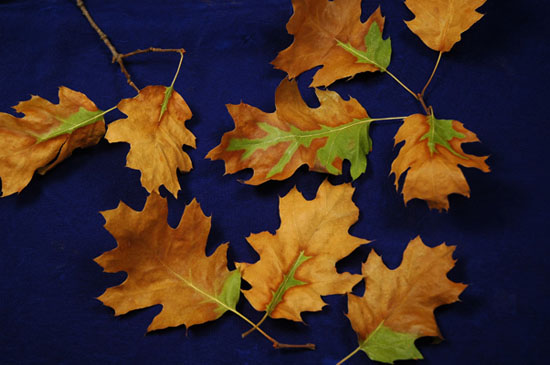Issue 13, August 8, 2011
Oak Wilt has been confirmed at the U of I Plant Clinic
As the dog days of summer begin, the appearance of obvious oak wilt symptoms throughout Illinois continues. The U of I Plant Clinic has already positively confirmed 3 cases of oak wilt this summer and is anticipating more positive cases to appear. Oak wilt is an extremely serious disease of oaks that can cause death to oaks in the red-black group (leaves with pointed tips) within a growing season and oaks in the white-bur group (leaves with rounded lobes) over several years. No oak species is immune.
Oak wilt is caused by the fungus, Ceratocystis fagacearum, which invades the water-conducting vessels of trees. The fungus kills by preventing water and nutrient flow, which can result in the wilting symptoms apparent in affected trees. Trees pruned before July 15th are the most likely to become infected as the fungus is most commonly transferred by sap feeding beetles. Trees can also become infected by root grafts.

Oak wilt symptoms on leaves (photo by Nancy Pataky)
On affected trees, leaves in the canopy of the tree will become discolored and wilt. By late summer, a tree in the red-black group will already be losing leaves. Affected trees of the white-bur group will have discolored leaves that remain on the tree. Oak wilt begins as scorching of leaves from tip back in sections or canopy of the tree. If you cut off a branch with affected leaves, and remove the bark, you may find streaking within the wood. This is a strong indicator that the tree may be infected with oak wilt, but it is not enough to provide a positive diagnosis.

Wood with obvious streaking
In order to confirm oak wilt, a sample must be cultured in the lab and due to the slow growing nature of the fungus; it usually takes about 10-14 days before a positive Identification can be made. Oaks that are infected with oak wilt will not recover and cannot be saved. A fungicide called Alamo is registered to use to protect trees from Oak Wilt, but it should not be used after infection is confirmed. Trees that test positive for oak wilt should be removed to prevent the spread of the disease.
The ideal sample for culturing the fungus that causes oak wilt should be from freshly wilting branches (NOT dead) that are 8 inches in length and about thumb width. If shipping, enclose 2-4 branches in a plastic bag (do not add water to the bag) and add a small bag of ice or frozen water bottle with the branches to preserve the sample. Samples can be sent to 1401 W St. Mary's Road, Urbana, IL 61801. Don't forget to include a U of I Plant Clinic submission form with your sample.
More information on oak wilt can be found in the University of Illinois Report on Plant Disease #618: Oak Wilt and Its Control.
Information on oak wilt culturing can be found on our web site as well. (Stephanie Porter and Mike Kwiatek)
Author:
Stephanie Porter